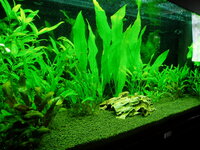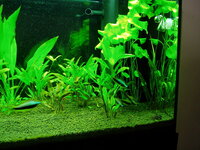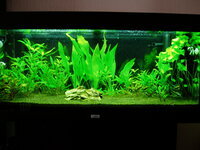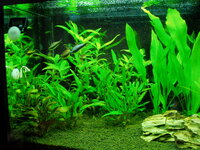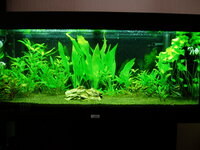Reading an earlier thread posted by Darrel about a chap and his blog ( good read by the way) kind of set my mind to thinking about ammonia absorption by plants in the tank and the effect on a canister filter.
I'm beginning to wonder if my 18 month old canister filter is still working biologically as it were.
To add a bit more detail, I'm currently running a Rio 180 tank with the internal filter still installed, with 70% of the sponges fitted and in addition a JBL 1501e underneath in the cabinet.
Plants are mostly crypts a few hygrophila and swords planted in a soil substrate and the critters are 12 tetras and half a dozen corydoras catfish.
The reason I'm beginning to suspect a problem is that when I clean the filter sponges there is next to no build up of mulm/detritus of any kind on any of the sponges at all. Sure there is some dirt in the bottom of the case as well as around the impellor but not much else considering the general poor state of the plants!.
Compare to my partners 306 canister on her 100 litre planted tank and after 6 weeks you could plant potatoes in all the crud that washes out of that filter. The difference between the two filters is chalk and cheese.
The same could be said about the health of the plants to tell you the truth!.
Plus I'm still getting diatoms! .............after 18 months!!.
I do approx. 80% water changes per week and I wonder what with this and my small fish load, what little ammonia there is, will be absorbed by the plants long before the bacteria in the filter gets it's chance.
Does this sound reasonable or am I over thinking it somewhat?.
I'm beginning to wonder if my 18 month old canister filter is still working biologically as it were.
To add a bit more detail, I'm currently running a Rio 180 tank with the internal filter still installed, with 70% of the sponges fitted and in addition a JBL 1501e underneath in the cabinet.
Plants are mostly crypts a few hygrophila and swords planted in a soil substrate and the critters are 12 tetras and half a dozen corydoras catfish.
The reason I'm beginning to suspect a problem is that when I clean the filter sponges there is next to no build up of mulm/detritus of any kind on any of the sponges at all. Sure there is some dirt in the bottom of the case as well as around the impellor but not much else considering the general poor state of the plants!.
Compare to my partners 306 canister on her 100 litre planted tank and after 6 weeks you could plant potatoes in all the crud that washes out of that filter. The difference between the two filters is chalk and cheese.
The same could be said about the health of the plants to tell you the truth!.
Plus I'm still getting diatoms! .............after 18 months!!.
I do approx. 80% water changes per week and I wonder what with this and my small fish load, what little ammonia there is, will be absorbed by the plants long before the bacteria in the filter gets it's chance.
Does this sound reasonable or am I over thinking it somewhat?.


